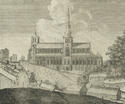 Glasgow Cathedral is one of the most ambitious buildings to have been erected in medieval Scotland and is the best surviving example of Gothic architecture in the country. It has a cruciform plan, but the short transepts do not project beyond the width of the aisles. At 170 metres in length Glasgow was surpassed in Scotland only by St Andrews. The choir and the nave are about the same size (62 by 40 metres), which reflects the size and importance of the chapter, the ecclesiastical community, attached to the cathedral. The nave, used by the laity effectively as the burgh parish church, was provided with a large number of altars built against the columns. The choir is screened off from the nave by a massive stone rood loft, a rare survival in Scotland. The most remarkable feature of the Cathedral is the crypt which extends under the full length of the choir and, owing to the slope of the ground, stands entirely above ground. A complex arrangement of columns and vaulting has been used to reveal the positions of the tomb of St Kentigern and five other chapels. The crypt has few rivals in Britain either in scale or beauty.
Glasgow Cathedral is one of the most ambitious buildings to have been erected in medieval Scotland and is the best surviving example of Gothic architecture in the country. It has a cruciform plan, but the short transepts do not project beyond the width of the aisles. At 170 metres in length Glasgow was surpassed in Scotland only by St Andrews. The choir and the nave are about the same size (62 by 40 metres), which reflects the size and importance of the chapter, the ecclesiastical community, attached to the cathedral. The nave, used by the laity effectively as the burgh parish church, was provided with a large number of altars built against the columns. The choir is screened off from the nave by a massive stone rood loft, a rare survival in Scotland. The most remarkable feature of the Cathedral is the crypt which extends under the full length of the choir and, owing to the slope of the ground, stands entirely above ground. A complex arrangement of columns and vaulting has been used to reveal the positions of the tomb of St Kentigern and five other chapels. The crypt has few rivals in Britain either in scale or beauty.
 The main body of the cathedral was built during the course of the 13th century, but some elements such as the chapter house, treasury/sacristy, the two western towers (now demolished) and Blackadder's Aisle were added later in the Middle Ages. Archaeological excavations have revealed evidence for two distinct phases which date to the 12th century. These earlier cathedrals were built in the same location, but were on a much smaller scale. The earliest of these was consecrated in 1136 and it was replaced at the end of the 12th century only to be replaced itself c. 1200. Of the first little can be said other than it was built in a Romanesque style, but the excavations recovered a number of painted architectural fragments which reveal that the interior was brightly painted with abstract patterns and figural scenes. This second cathedral was also built on two levels and a very small portion of the south-east transept survives in the crypt.
The main body of the cathedral was built during the course of the 13th century, but some elements such as the chapter house, treasury/sacristy, the two western towers (now demolished) and Blackadder's Aisle were added later in the Middle Ages. Archaeological excavations have revealed evidence for two distinct phases which date to the 12th century. These earlier cathedrals were built in the same location, but were on a much smaller scale. The earliest of these was consecrated in 1136 and it was replaced at the end of the 12th century only to be replaced itself c. 1200. Of the first little can be said other than it was built in a Romanesque style, but the excavations recovered a number of painted architectural fragments which reveal that the interior was brightly painted with abstract patterns and figural scenes. This second cathedral was also built on two levels and a very small portion of the south-east transept survives in the crypt.